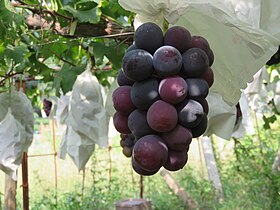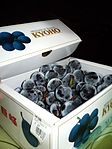
Table grapes are grapes intended for consumption as fresh fruit as opposed to grapes grown for wine production, juice production, jelly and jam making or for drying into raisins.
Vitis vinifera table grapes can be in the form of either seeded or non-seeded varietals and range widely in terms of colour, size, sweetness and adaptability to local growing conditions.
Common commercially available table grape varieties such as Thompson Seedless and Flame Seedless are favoured by growers for their high yield and relative resistance to damage during shipment. Other less common varietals such as Cotton Candy, Kyoho or Pione are custom hybrids bred for size, appearance and specific flavour characteristics.
Market characteristics
Chile, Peru, the United States, China, Turkey, Spain, South Africa and Australia are all major producers and exporters of table grapes. World table grape production in 2016 is estimated by the USDA to be in the region of 21.0 million metric tons per annum, China alone accounting for an estimated 9.7 million metric tons of this global total. Chile remains the world's single largest table grape exporter, exporting over 800,000 metric tons to mainly North American and European markets. China, by way of contrast, exports only 247,000 metric tons per annum mainly to South East Asian markets; a small percentage of overall production.
The global trade in table grapes has enjoyed strong growth since the 1950s. Since the turn of the century table grape export growth has primarily come from the Southern Hemisphere and developing economies such as Chile, India, Peru and Turkey.
The international trade in table grapes has significantly benefitted from the increased availability of cold storage and refrigerated container technology. Table grapes are a labour-intensive agricultural product that require harvesting by hand at peak ripeness. In order to maintain product quality at point of sale, harvested grapes must be sorted, packaged and cooled to near 0 °C as quickly as possible. Transportation in ventilated and temperature controlled environments requires significant investment in processing facilities, shipping and logistics. As the production cycle for table grapes is relatively long compared with other fruit, with new plantations taking 2–3 years to become productive, export production and promotion is often concentrated in the hands of large vertically integrated commercial enterprises or producer-exporter associations such as the Fruit Exporters Association of Chile (ASOEX).
North America and Europe
Table grapes commonly sold in North American and European markets include Sultana (Thompson Seedless), Flame, Muscat, Almeria, Niagara and Concord.
In the United States, California remains the largest single producer of table grapes with over 85,000 acres under cultivation. According to the USDA over 70 varietals are grown in the state, but the bulk of shipments are limited to a dozen mainly seedless varieties often sold domestically under generic green, red, or black descriptors.
Japan, Korea and East Asia
In Japan, Korea and other East Asian markets, as well as supporting a market for imported grapes commonly produced in Australia and Chile, domestically produced table grapes are often grown and sold as premium gift products.
In Japan, Kyoho, Delaware and Pione grapes rank as the first, second and third most popular table grapes in terms of production volume. In July 2015, setting new pricing records for Japanese premium table grapes, a single bunch of Ruby Roman grapes, containing 26 grapes at a weight of about 700 grams, sold for 1 million yen (around US$8400).
In the Philippines, most table grapes in the country are imported, although grapes can be cultivated in the islands. In the Ilocos region, the red cardinal is the most commonly grown variety.
Varietals
Main article: List of grape varieties| Colour | Varietals |
|---|---|
| White-Green grapes | Perlette, Sugraone, Thompson Seedless, Niagara, Calmeria, Italia, Autumn King, Princess, Cotton Candy, Shine Muscat |
| Red grapes | Flame Seedless, Swenson Red, Yates, Red Globe, Ruby Seedless, Christmas Rose, Emperor, Rouge, Crimson Seedless, Tudor Premium Red, Scarlet Royal, Cardinal, Koshu, Delaware, Ruby Roman, Vintage Red, Muscato |
| Blue-Black grapes | Beauty Seedless, Concord, Thomcord, Muscat Hamburg, Autumn Royal, Fantasy Seedless, Marroo, Niabell, Summer Royal, Kyoho, Pione, St. Theresa |
Gallery
-
Sultana (Thompson Seedless) table grapes
-
 Autumn Royal table grapes California
Autumn Royal table grapes California
-
 Ruby Roman grapes for sale in Kanazawa, Ishikawa Prefecture
Ruby Roman grapes for sale in Kanazawa, Ishikawa Prefecture
-
 Kyoho grapes
Kyoho grapes
See also
References
- Creasy, Glenn (2009). Grapes. Oxfordshire: CAB International. p. 225. ISBN 978-1-84593-401-9.
- "Fresh Deciduous Fruit (Apples, Grapes & Pears): World Markets and Trade" (PDF). USDA. Foreign Agriculture Service. Archived from the original (PDF) on 30 July 2016. Retrieved 25 September 2015.
- "Fresh Deciduous Fruit: World Markets" (PDF). USDA. United States Department of Agriculture. Archived from the original (PDF) on 30 July 2016. Retrieved 5 July 2016.
- Fernandez-Stark, Karina (2016). Peru in the Table Grape Global Value Chain (PDF). Report commissioned by the World Bank. p. 8. Archived from the original (PDF) on 9 March 2016. Retrieved 6 July 2016.
- Fernandez-Stark, Karina (2016). Peru in the Table Grape Global Value Chain (PDF). Report commissioned by the World Bank. p. 11. Archived from the original (PDF) on 9 March 2016. Retrieved 6 July 2016.
- Boyd, Vicky. "A dozen varieties lead California table grape market". The Packer. Retrieved 5 July 2016.
- Robinson, Jancis (2015). The Oxford Companion to Wine (4th ed.). Oxford: Oxford University Press. p. 391. ISBN 978-0-19-870538-3.
- Du, Lisa (9 July 2015). "Bunch of Grapes Sells for Record $8,200". Wall Street Journal. Retrieved 9 July 2015.
- "Codex Standard on Table Grapes undergoing Adoption to Philippine National Standard: Field Date Gathering Conducted". Philippine Information Agency. Bureau of Agriculture and Fisheries Standards. 26 May 2021. Retrieved 26 May 2021.